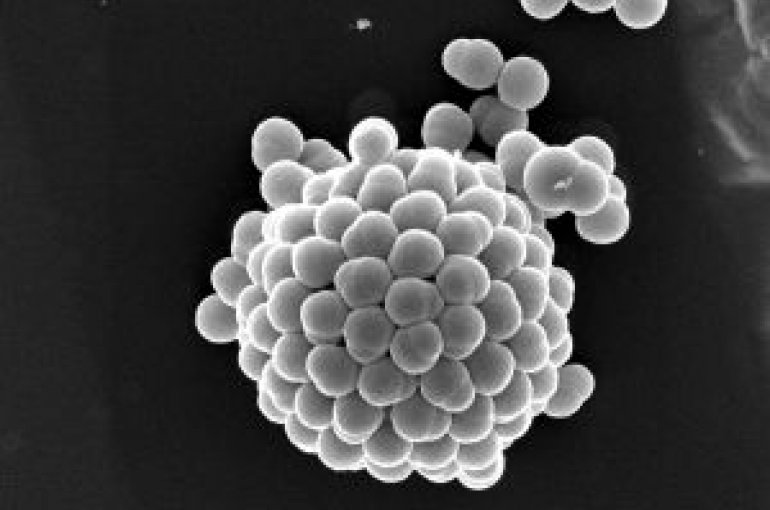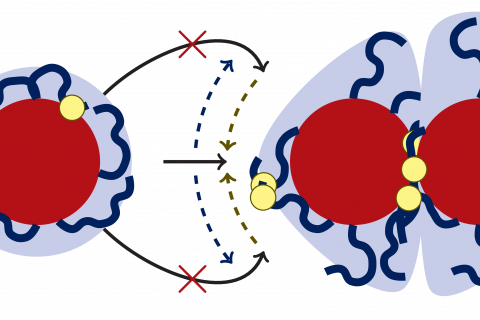Plastic particles spontaneously form virus-like structure
Nature-publication: Simple model particles for complex systems

Model particles that are easy to produce in the laboratory can be used to study how complex biological structures are created. That is the conclusion of a study by Dutch physical chemists which will be published in the online version of Nature on 8 June. In the study, the researchers show how the particles can arrange themselves into a layer that is similar to the protein shell around a virus. “The preliminary results of our research into these model particles lead us to suspect that deformability and asymmetry are crucial for the formation of complex biological nanostructures”, according to research project leader Prof. Willem Kegel from Utrecht University.
Kegel and his Doctoral Candidate Chris Evers wanted to design new particles as a model system for viruses. “A virus is a very complex system to study at the molecular level”, explains Kegel. “It consists of several proteins that form a shell around the virus’ genetic material. Once the virus penetrates into a host cell, the protein layer opens up to release the DNA and allow the virus to multiply. Our model particles are hundreds of times larger than the building blocks of a virus, so we can directly observe how they arrange themselves under a microscope.”
Three crucial characteristics
These micro-particles, which are simple to produce in the lab, are deformable, a bit asymmetrical, and can both attract and repel other particles. They share these characteristics with much more complex biomolecules, such as proteins. To their astonishment, the first particle that Evers produced immediately began to form layered structures, although the researchers almost overlooked it. “It’s mainly thanks to Chris’ imaginative mind that we were able to find this amazing result”, says Kegel. “He saw that a virus-like structure had formed, even though we hadn’t expected that from such simple particles.”
Particle characteristics determine its structure
With the help of computer simulations performed by the co-authors Dr. Jurriaan Luiken and Prof. Peter Bolhuis from the University of Amsterdam, the researchers also showed that the degree of the particles’ deformability determines the number of bonds with other particles. This may make it possible to produce particles that can arrange themselves in specific structures; in this case, a structure that resembles the protein shell around a virus. In principle, this method also enables scientists to design new structures, such as nanocapsules that can deliver medication to a specific location in the body.

Process comparable to biomolecules
The plastic particles are deformable because they have two types of polymer molecules onto their surface. One type of molecule repels one another, while the other type attracts. When two particles approach one another, the polymer molecules rearrange themselves. The molecules that attract one another seek the contact regions between the particle, while the molecules that repel one another move out of the contact regions. “We suspect that this process is similar to what happens when two complex biomolecules approach one another”, according to the research project leader Willem Kegel, Professor of Self-Organising Systems at Utrecht University.
Choosing the right proportions
Selecting the right proportion of attractive and repulsive polymer molecules creates hollow structures that resemble the protein coat around a virus. The attractive polymer molecules, combined with a slight asymmetry, make the particles bond and bend. The repulsive polymer molecules that are depleted from the contact regions prevent a new layer of plastic particles from forming, which would create a disordered cluster.
It’s mainly thanks to Chris’ imaginative mind that we were able to find this amazing result.
Dissertation
Chris Evers will defend his dissertation on 29 June. The publication in Nature is one of the chapters of his dissertation.
Publication
‘Self-assembly of Microcapsules via Colloidal Bond Hybridization and Anisotropy’
Chris H.J. Evers*, Jurriaan A. Luiken, Peter G. Bolhuis and Willem K. Kegel*
Nature, 8 June 2016 online, in print 16 June
* affiliated with Utrecht University
This study was financed in part by a TOP-GO grant (Kegel) and a Vici grant (Bolhuis) provided by NWO.
Contact
Monica van der Garde, Press Spokesperson, Utrecht University, m.vandergarde@uu.nl, 06 13 66 14 38.

